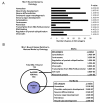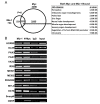Myc and Miz-1 have coordinate genomic functions including targeting Hox genes in human embryonic stem cells
- PMID: 22053792
- PMCID: PMC3226433
- DOI: 10.1186/1756-8935-4-20
Myc and Miz-1 have coordinate genomic functions including targeting Hox genes in human embryonic stem cells
Abstract
Background: A proposed role for Myc in maintaining mouse embryonic stem (ES) cell pluripotency is transcriptional repression of key differentiation-promoting genes, but detail of the mechanism has remained an important open topic.
Results: To test the hypothesis that the zinc finger protein Miz-1 plays a central role, in the present work we conducted chromatin immunoprecipitation/microarray (ChIP-chip) analysis of Myc and Miz-1 in human ES cells, finding homeobox (Hox) genes as the most significant functional class of Miz-1 direct targets. Miz-1 differentiation-associated target genes specifically lack acetylated lysine 9 and trimethylated lysine 4 of histone H3 (AcH3K9 and H3K4me3) 9 histone marks, consistent with a repressed transcriptional state. Almost 30% of Miz-1 targets are also bound by Myc and these cobound genes are mostly factors that promote differentiation including Hox genes. Knockdown of Myc increased expression of differentiation genes directly bound by Myc and Miz-1, while a subset of the same genes is downregulated by Miz-1 loss-of-function. Myc and Miz-1 proteins interact with each other and associate with several corepressor factors in ES cells, suggesting a mechanism of repression of differentiation genes.
Conclusions: Taken together our data indicate that Miz-1 and Myc maintain human ES cell pluripotency by coordinately suppressing differentiation genes, particularly Hox genes. These data also support a new model of how Myc and Miz-1 function on chromatin.
Figures







References
Grants and funding
LinkOut - more resources
Full Text Sources
Research Materials

